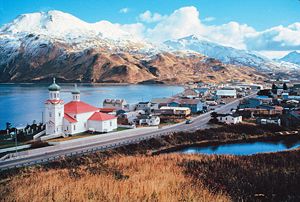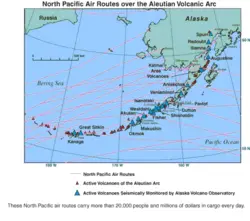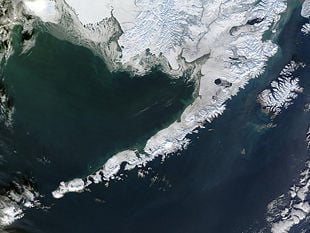Aleutian Islands
The Aleutian Islands (possibly from Chukchi aliat, "island") are a chain of more than 150 mostly volcanic islands forming an island arc that seperates the Bering Sea (in the north) from the main portion of the Pacific Ocean. These islands occupy an area of 6,821 sq mi (17,666 km²) and extend about 1,100 mi (1,800 km) westward from the tip of the Alaska Peninsula toward Attu Island in Alaska. Crossing longitude 180°, they are the westernmost part of the United States (and technically also the easternmost; see Extreme points of the United States). Nearly all the archipelago is part of Alaska and usually considered as being in the "Alaskan Bush", including the small, geologically-related, and remote Komandor Islands, (Russia)at the extreme western end. The islands, including their 57 volcanoes, are in the northern part of the Circum-Pacific chain of volcanoes, commonly referred to as the Pacific Ring of Fire. The Alaska Marine Highway passes through the islands, which includs the Unimak, Umnak, Amukta, and Seguam passes. [1]
Geography
The islands, known before 1867 as the Catherine Archipelago, comprise five groups: the Fox which is nearest to the mainland, Islands of Four Mountains, Andreanof, Rat and Near islands, the smallest and most western group. They are all located between 51° and 55° N latitude and 173° E and 161° W longitude.
The axis of the archipelago near the mainland of Alaska has a southwest trend, but near the 129th meridian its direction changes to the northwest. This change of direction corresponds to a curve in the line of volcanic fissures that have contributed their products to the building of the islands. Such curved chains are repeated about the Pacific Ocean in the Kuril Islands, the Japanese chain and in the Philippines. All these island arcs are at the edge of the Pacific Plate and experience a lot of seismic activity, but are still habitable; the Aleutians lie between the Pacific and North American tectonic plates. The general elevation is greatest in the eastern islands and least in the western. The island chain is a western continuation of the Aleutian Range on the mainland.
The great majority of the islands bear evident marks of volcanic origin, and there are numerous volcanic cones on the north side of the chain, some of them active; many of the islands, however, are not wholly volcanic, but contain crystalline or sedimentary rocks, and also amber and beds of lignite. The coasts are rocky and surf-worn, and the approaches are exceedingly dangerous, the land rising immediately from the coasts to steep, bold mountains.
Makushin Volcano (5691 ft/1,735 m) located on Unalaska Island, is not quite visible from within the town of Unalaska, though the steam rising from its cone is visible on a (rare) clear day. Denizens of Unalaska need only to climb one of the smaller hills in the area, such as Pyramid Peak or Mt. Newhall, to get a good look at the snow-covered cone. The volcanic Bogoslof and Fire Islands, which rose from the sea in 1796 and 1883 respectively, lie about 30 miles (48 km) west of Unalaska Bay.
Climate
The climate of the islands is oceanic, with moderate and fairly uniform temperatures and heavy rainfall. Fogs are almost constant. Summer weather is much cooler than Southeast Alaska (Sitka), but the winter temperature of the islands and of the Alaska Panhandle is very nearly the same. The mean annual temperature for Unalaska, the most populated island of the group, is about 38 °F (3.4 °C), being about 30 °F (−1.1 °C) in January and about 52 °F (11.1 °C) in August. The highest and lowest temperatures recorded on the islands are 78 °F (26 °C) and 5 °F (−15 °C) respectively. The average annual rainfall is about 80 in (2,030 mm), and Unalaska, with about 250 rainy days per year, is said to be one of the rainiest places within the United States. This type of climate is only comparable to those of: Iceland, Tierra del Fuego and neighboring Alaska Peninsula.
Flora
The growing season lasts about 135 days, from early in May till late in September, but agriculture is limited to the raising of a few vegetables. With the exception of some stunted willows, the vast majority of the chain is destitute of native trees. On some of the islands, such as Adak and Amaknak, there are a few coniferous trees growing, remnants of the Russian period. But these trees, some of them estimated to be two hundred years old, rarely reach a height of even ten feet, and many of them are still less than five feet tall, this is because summers are not hot enough to favor a good growth for those trees brought from Sitka(where summers reach 14 ºC), while in other parts of the world like Tierra del Fuego (which trees have not been introduced in the islands); native forests tolerate very cold temperatures in summer (9º C)
Instead of trees, the islands are covered with a luxuriant, dense growth of herbage, including grasses, sedges and many flowering plants.
Economy
On the less mountainous islands, the raising of sheep and reindeer was once believed to be practicable. During the 1980s, there were some llama being raised on Unalaska. Today, the economy is primarily based upon fishing, and, to a lesser extent, the presence of American military.
Demographics
The native people refer to themselves as Unangan, and are now generally known by most non-natives as the "Aleut".
The Aleut language is one of the two main branches of the Eskimo-Aleut language family. This family is not known to be related to any others.
In the 2000 census, there was a population of 8,162 on the islands, of whom 4,283 were living in the main settlement of Unalaska.
History
Prehistory
Because of the location of the islands, stretching like a broken bridge from Asia to America, many anthropologists believe they were a route of the first human occupants of the Americas. The earliest known evidence of human occupation in the Americas is much further south, in New Mexico and Peru; the early human sites in Alaska have probably been submerged by rising waters during the current interglacial period. People living in the Aleutian Islands developed fine skills in hunting, fishing, and basketry. Hunters made their weapons and watercraft. The baskets are noted for being finely woven with carefully shredded stalks of beach rye.
Russian period
Explorers, traders, colonists, and missionaries arrived from Russia beginning in 1741.
In 1741 the Russian government sent Vitus Bering, a Dane in the service of Russia, and Alexei Chirikov, a Russian, in the ships Saint Peter and Saint Paul on a voyage of discovery in the Northern Pacific. After the ships were separated by a storm, Chirikov discovered several eastern islands of the Aleutian group, and Bering discovered several of the western islands, finally being wrecked and losing his life on the island of the Komandorski Islands (Commander Islands) that now bears his name (Bering Island). The survivors of Bering's party reached the Kamchatka Peninsula in a boat constructed from the wreckage of their ship, and reported that the islands were rich in fur-bearing animals.
Siberian fur hunters flocked to the Commander Islands and gradually moved eastward across the Aleutian Islands to the mainland. In this manner Russia gained a foothold on the northwestern coast of North America. The Aleutian Islands consequently belonged to Russia, until that country transferred all its possessions in North America to the United States in 1867.
The Russians were ruthless in their expansion, using technology and cruelty to enslave the Aleuts, especially for sea otter hunting. The Russians captured otter pelts from the Aleutian Islands, through the Gulf of Alaska, along the Alaska Panhandle, and south, even to California. Some Aleuts were moved to the Pribilof Islands so that fur seals could be captured there as well.
By 1760, the Russian merchant Andrian Tolstykh had made a detailed census in the vicinity of Adak and extended Russian citizenship to the Aleuts.
Despite some attempts to eliminate slavery and reduce cruel treatment in the 1790s, the Shelikhov company depended on the labor of Aleut hunters to collect sea otter pelts.
During his third and last voyage, in 1778, Captain James Cook surveyed the eastern portion of the Aleutian archipelago, accurately determined the position of some of the more important islands and corrected many errors of former navigators.
Christian influences
One of the first Christian missionaries to arrive in the Aleutian Islands was a monk named Herman, who arrived in 1793 with nine other Russian Orthodox monks and priests. Within two years, he was the only survivor of that party. He settled on Spruce Island, near Kodiak Island, and often defended the rights of the Aleuts against the Russian trading companies. He is now known in the Orthodox Church as St. Herman of Alaska.
Another early Christian missionary of the Russian Orthodox Church was Father Veniaminov who arrived in Unalaska in 1824. He was named Bishop Innokentii in 1840 and moved to Sitka. He is now known in the Orthodox Church as Saint Innocent of Alaska.
The principal settlements were on Unalaska Island. The oldest was Iliuliuk (also called Unalaska), settled in 1760-1775, with a customs house and an Orthodox church.
US possession
After the American purchase of Alaska from Russia in 1867, further development took place. New buildings included a Methodist mission and orphanage, and the headquarters for a considerable fleet of United States revenue cutters which patrolled the sealing grounds of the Pribilof Islands. The first public school in Unalaska opened in 1883.
The U.S. Congress extended American citizenship to all Natives (and this law has been held to include the indigenous peoples of Alaska) in 1924.
A hospital was built in Unalaska in 1933 by the US Bureau of Indian Affairs.
World War II
During World War II, small parts of the Aleutian islands were occupied by Japanese forces, when Attu and Kiska were invaded in order to divert American forces away from the main Japanese attack at Midway Atoll. The U.S. Navy, having broken the Japanese naval radio codes, knew that this was just a diversion, and it did not expend large amounts of effort in defending the islands. A few Americans were taken to Japan as prisoners of war. Most of the civilian population of the Aleutians were interned by the United States in camps in the Alaska Panhandle. American forces invaded Japanese-held Attu and defeated the Japanese, and subsequently regained control of all the islands. See: Battle of the Aleutian Islands. The islands were also a stopping point for hundreds of aircraft sent from California to Russia as part of the war effort.
Monday, June 3, 2002 was celebrated as Dutch Harbor Remembrance Day. The governor of Alaska ordered state flags lowered to half-staff to honor the 78 soldiers who died during the two-day Japanese air attack in 1942. The Aleutians World War II Campaign National Historic Area Visitors Center opened in June 2002.
Recent and miscellaneous developments
The Alaska Native Claims Settlement Act (ANCSA) became law in 1971. In 1977, the Ounalashka Corporation (from Unalaska) declared a dividend. This was the first village corporation to declare and pay a dividend to its shareholders.
In 1906 a new volcanic cone rose between the islets of Bogoslof and Grewingk, near Unalaska, followed by another in 1907. These cones were nearly demolished by an explosive eruption on 1 September 1907.
Miscellaneous
The Aleutian Islands would likely be an important part of the National Missile Defense system proposed to defend the United States from small ballistic missile attacks.
See also
- List of Aleutian Islands
- List of Aleutian Island Volcanoes
- Aleutians West Census Area, Alaska
- Aleutians East Borough, Alaska
- Battle of the Aleutian Islands
- Peter the Aleut

Western Aleutian Islands, from a 1916 map of the Alaska Territory
ReferencesISBN links support NWE through referral fees
- This article incorporates text from the Encyclopædia Britannica Eleventh Edition, a publication now in the public domain.
http://www.hlswilliwaw.com/aleutians/
Total area of 6,821 sq mi from Encyclopædia Britannica Online
Template:Alaska
| Regions of the world | |||||||||||||||||||||||||
|---|---|---|---|---|---|---|---|---|---|---|---|---|---|---|---|---|---|---|---|---|---|---|---|---|---|
|
| ||||||||||||||||||||||||
| See also Continents of the world | |||||||||||||||||||||||||
Credits
New World Encyclopedia writers and editors rewrote and completed the Wikipedia article in accordance with New World Encyclopedia standards. This article abides by terms of the Creative Commons CC-by-sa 3.0 License (CC-by-sa), which may be used and disseminated with proper attribution. Credit is due under the terms of this license that can reference both the New World Encyclopedia contributors and the selfless volunteer contributors of the Wikimedia Foundation. To cite this article click here for a list of acceptable citing formats.The history of earlier contributions by wikipedians is accessible to researchers here:
The history of this article since it was imported to New World Encyclopedia:
Note: Some restrictions may apply to use of individual images which are separately licensed.




